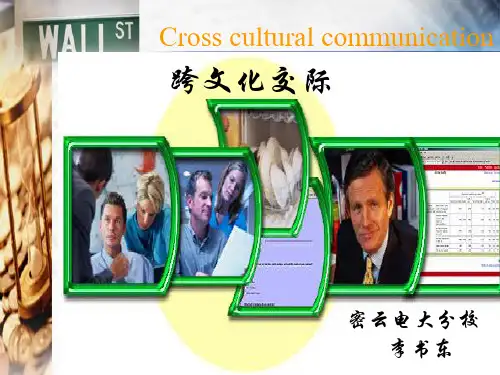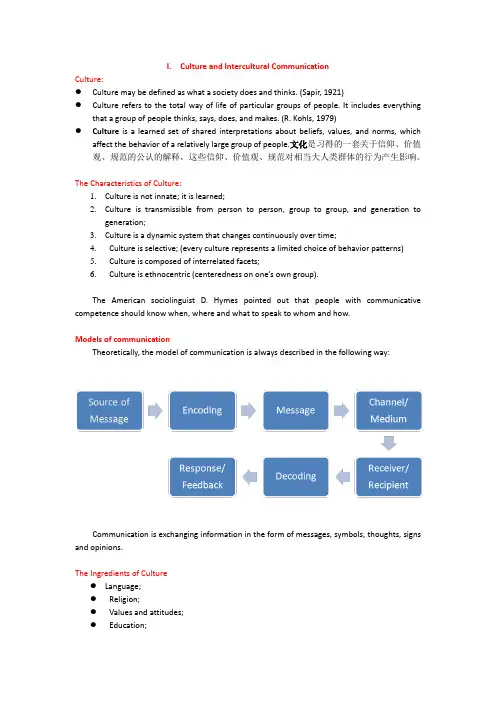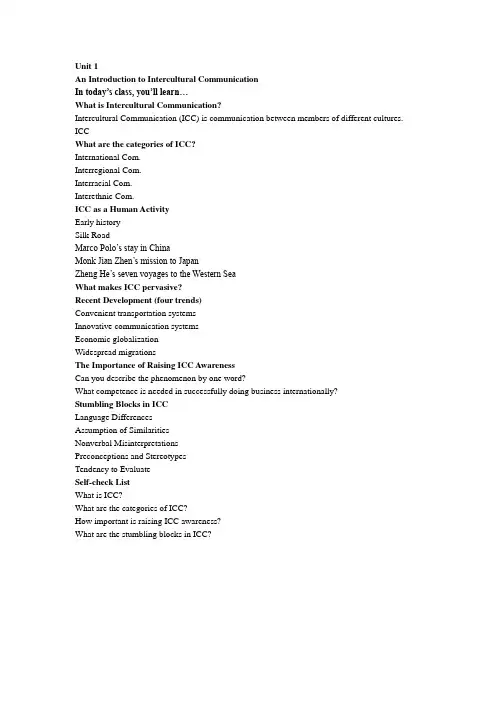中英文-珍贵-跨文化交际学概论课件资料全
- 格式:doc
- 大小:124.00 KB
- 文档页数:14





I. Culture and Intercultural CommunicationCulture:●Culture may be defined as what a society does and thinks. (Sapir, 1921)●Culture refers to the total way of life of particular groups of people. It includes everythingthat a group of people thinks, says, does, and makes. (R. Kohls, 1979)●Culture is a learned set of shared interpretations about beliefs, values, and norms, whichaffect the behavior of a relatively large group of people.文化是习得的一套关于信仰、价值观、规范的公认的解释,这些信仰、价值观、规范对相当大人类群体的行为产生影响。
The Characteristics of Culture:1.Culture is not innate; it is learned;2.Culture is transmissible from person to person, group to group, and generation togeneration;3.Culture is a dynamic system that changes continuously over time;4.Culture is selective; (every culture represents a limited choice of behavior patterns)5.Culture is composed of interrelated facets;6.Culture is ethnocentric (centeredness on one’s own group).The American sociolinguist D. Hymes pointed out that people with communicative competence should know when, where and what to speak to whom and how.Models of communicationTheoretically, the model of communication is always described in the following way:Communication is exchanging information in the form of messages, symbols, thoughts, signs and opinions.The Ingredients of Culture●Language;●Religion;●Values and attitudes;●Education;●Social organization;●Technology and material culture;●Politics;●LawIntercultural Communication (IC)●In its most general sense, IC refers to those occasions when a member of oneculture produces a message for consumption by a member of another culture. (p70, Samovar & Porter)●More precisely, IC refers to communication between people whose cultureperceptions and symbol systems are distinct enough to alter the communication event.(p70, Samovar & Porter)跨文化交际: 指拥有不同文化认知和符号体系的人们之间进行的交际。


An Introduction to Intercultural CommunicationIn today’s class, you’ll learn…What is Intercultural Communication?Intercultural Communication (ICC) is communication between members of different cultures. ICCWhat are the categories of ICC?International Com.Interregional Com.Interracial Com.Interethnic Com.ICC as a Human ActivityEarly historySilk RoadMarco Polo’s stay in ChinaMonk Jian Zhen’s mission to JapanZheng He’s seven voyages to the Western SeaWhat makes ICC pervasive?Recent Development (four trends)Convenient transportation systemsInnovative communication systemsEconomic globalizationWidespread migrationsThe Importance of Raising ICC AwarenessCan you describe the phenomenon by one word?What competence is needed in successfully doing business internationally?Stumbling Blocks in ICCLanguage DifferencesAssumption of SimilaritiesNonverbal MisinterpretationsPreconceptions and StereotypesTendency to EvaluateSelf-check ListWhat is ICC?What are the categories of ICC?How important is raising ICC awareness?What are the stumbling blocks in ICC?Understanding CommunicationIn this class, you’ll be able toI. know different definitions of communicationII. identify various ingredients of communicationIII. analyze a communication process and recognize the components of communicationIV. identify the characteristics of communicationWhat is Communication?交际intercourse沟通link upTransmission of information (a message) between a source (sender) and a receiver, by using signaling system. (Oxford Dictionary)Communication is the process of exchanging information and meaning between or among individuals through a common system of symbols, signs, and behavior.Communication is a dynamic, systematic process in which meanings are created and reflected in human interaction with symbols.Features of CommunicationInteractive, systematic, symbolicII. Basic Ingredients of CommunicationSource (sender)EncodingMessageChannelReceiverDecodingSelf-check ListWhat is Communication?What are the features of Communication?What is the process of Communication?Verbal Communication—Lexical LevelIn today’s class, we will …understand the cultural influences on the meanings of wordsanalyze denotative and connotative differences between English and Chinese words I. Types of Lexical MeaningDenotation: primary, explicit, conceptualConnotation: supplementary, implicitCultural differences in denotative meaningA. Absence of equivalents in the speaker or listener's languageThe absence of the object “Kang”The absence of the word “Kang”The absence of objects, events, concepts, etc.The absence of the necessary vocabularyII. Cultural Differences in Denotative MeaningsB. The overlapping of denotative meaningKinship vocabularyuncle, aunt, grandpa, grandma, brother, sister, niece, nephew, cousinIII. Cultural differences in Connotative MeaningsFamilyKorean Top 3: mother father: children, brother, sister: relativeUSA Top 3: mother father: children, brother, love and friendshipMarriageUSA Top 3:Love; respect; responsibilitiesJapan Top 3:Trust; family; understandingFrance Top 3:Love; passion; sexColor WordsAnimal wordsChinese DragonWestern Dragon ImagePhonixDogOwlBatSelf-check ListThe cultural influences on the meanings of wordsDenotation and connotationThe connotations of some color words and animal wordsVerbal Communication—Pragmatic LevelIn today’s class, we will…look at cultural differences on pragmatic levelAddressingCompliments and Compliment ResponsesApologizingdiscuss on how these superficial behaviors are related to the cultural assumptions of the speakers I. AddressingA. Surnames and Given namesB. Addressing family members, relatives and neighborsC. The Use of TitlesIn Chinese : 宋局长,高经理,刘老师In English:Dr., Mrs., Miss, Ms, Mr. Judge, Governor, Mayor, PresidentD. The ways of getting the attention of a strangerIn Chinese: 同志,师傅,大哥,叔叔,……In English: Excuse me, Pardon meThe root of these differences lies in…Hierarchy & FormalityEqualityII. Compliments and Compliment ResponsesDifferences Between Chinese and English ComplimentsWho and what to complimentHow to complimentHow often to complimentHow to respond a complimentMembers of one’s familyA woman’s appearanceThe root of these differences lies in…MODESTYEqualityIII. ApologizingWhen to apologizeWho to apologizeHow to apologize and how to respondSelf-check ListCultural Differences on the Pragmatic LevelAddressing peopleCompliments and Compliment ResponsesApologizingNonverbal Communication (I)In today’s class, we will…understand what nonverbal communication is;know the function nonverbal communication serves;find out the elements of nonverbal communication;gain an awareness that successful ICC also depends on behaviors we displayI. Understanding Nonverbal CommunicationNVC involves all those nonverbal stimuli in a communication setting that are generated by both the source and his / her use of the environment and that have potential message value for the source or receiver. (Samovar, 2000: 149)Which carries more of the meaning, verbal or nonverbal communication?The importance of NVCII. The Functions of NVCWhen we say “The new library is south of that building”, we usually point in a certain direction. You tell someone that you are pleased with his/her performance, and at the same time you pat the person on the shoulder.If people in a group are boisterous, you might place your index finger to your lips as an alternative to saying, “Please calm down so that I can speak.”In a conversation we nod our head in agreement to indicate to our partners in communication that we agree and that they should continue talking.Just before the exam, you tell me you are relaxed and at ease, yet your voice quavers and your hands shake.III. Elements of Nonverbal Communication参见课本图例1. Making a GestureThe ring gestureBritain: _____France: _____Tunisia: ______U.S.: _____Latin America: _____Japan: _____The thumbs-upBritain: _____ & _____Sardinia: _____Greece: _____BeckoningAmerica: _____Malaysia: _____Yugoslavia: _____Indonesia: _____Australia: _____China: _____Pulling down the lower lid of the eye with one fingerFrance and Greece: _____England: _____Spain and Italy: _____South America: _____Ear-tugSpain: _____Greece: _____Malta: _____Italy: _____V-signBritain: _____Greece: _____2. PostureJapanese — bowing Status and rankAmericans — slouching Relaxed, informal attitude3. Facial ExpressionsMediterranean cultures: exaggerate signs of grief and sadness.U.S.: Men suppress the desire to show their emotions.China: Men never shed tears unless in extremely strongly-struck occasions.Japan: Men hide expressions by laughing or smiling.Smile = friendship?Far East: cover up embarrassment, dismay or furyJapan: mask an emotion; to avoid answering a question; to hide embarrassmentFrance: a person who grins too much =simpleGermany: smiles are reserved for family, friend and social situations, not in business settings.4. ParalanguageSelf-check ListThe definition of NVCThe functions of NVCThe elements of NVCGestures, postures, facial expressionsUnit 6Nonverbal Communication (II)— SPACE & TIMEElements of Nonverbal Communication参见书上图例In today’s class, we will…appreciate how attitude toward use of space and time convey nonverbal messages in ICC I. SpaceSpace speaks.When you invade my space, I will…feel troubledget defensivebecome aggressiveretaliateProxemicsthe study of personal space for the purpose of communication 近体学“Body Bubbles”American Interpersonal Distance (Hall, 1966)Intimate distancePersonal distanceSocial distancePublic distanceZones of SpaceIntimate distance0-45 centimetersPersonal distance45-80 centimetersSocial distance1.3-3 metersPublic distancefarther than 2 or 3 metersNorthern American Zones of SpaceCultural styles also determine the amount of personal space.Culture Variation of Body DistanceSmall space -----------------------------------------Large spaceJapaneseGermanAmericanFrenchArabLatin AmericanTouching times recorded in an hourTerritorialitythe pattern behavior associated with the defense of a territory 领地性The way people perceive territoriality is strongly influenced by culture.Cultural influence on territoriality can be best illustrated from the following two aspects: Attitudes towards crowdingPrivacyCrowding — how people feel when their personal space is limitedCausesPrivacyWesterners have a strong sense of privacy.Oriental culture does not emphasize privacy.Western View of Privacy“A man’s home is his castle.”Japanese View of PrivacyShoji Screen DoorsFusuma Sliding DoorsTatami FloorsII. TimeTime talksChronemicsThe study of the use and perception of timeTwo ways to study the concept of time(1) perceptions of past, present and future(2) monochronic vs. polychronicPast-oriented culturesemphasize tradition and historydiscourage change and innovationChina, Saudi ArabiaPresent-oriented culturesconsider the present as the only precious moment“Seize the day!”Mexico, the BahamasFuture-oriented culturesemphasize planning in order to achieve goalsencourage change and innovationU.S.Monochronic (一元时间) vs. polychronic(多元时间)M-time is noted for its emphasis on schedules, segmentation and promptness.P-time is less rigid and clock-bound.Self-check ListNVCspace Timeproxemics territoriality chronemicscrowding past monochronicprivacy present polychronicfutureUnit 7Cross-gender CommunicationIn today’s class, you will…understand the differences between male and female in communication learn effective cross-gender communication principlesThe Styles of CommunicationDebate vs. RelateReport vs. RapportCompetitive vs. CooperativeGender Differences in CommunicationBody languageFacial expressionSpeech patternsBehaviorPrinciples for Effective Cross-gender CommunicationB. Suspend JudgmentD. Recognize the Validity of Different Communication StylesA. Provide Translation CuesE. Seek Translation CuesC. Enlarge Your Own Communication StyleF. Suspend JudgmentSelf-check ListGender differences in communicationBody languageFacial expressionSpeech patternbehaviorSix principles for effective cross-gender communicationUnit 8Understanding CultureIn today’s class, we’ll…⏹understand the definitions of culture;⏹identify the ingredients of culture;⏹describe the features of culture.I.What is Culture?⏹Culture is everything.⏹Culture is opera, art, and ballet.⏹Culture may be defined as what a society does and thinks.⏹What really binds men together is their culture.⏹ A culture is a collections of beliefs, habits, living patterns and behaviors which areheld more or less in common by people who occupy particular geographic areas.Define culture from different perspectivesFrom Intellectual PerspectiveFrom Anthropological PerspectiveFrom Social PerspectiveFrom Intercultural Communication PerspectiveFrom Intellectual Perspective⏹According to the Concise Oxford Dictionary, culture is “the arts and othermanifestations of human intellectual achievement regarded collectively”.From Anthropological Perspective⏹Culture is “the customs, civilizations, and achievements of a particular time orpeople”.⏹This is an anthropologist’s definition.From Social Perspective⏹Culture is what a society does and thinks.⏹Culture covers everything of a society.From Intercultural Communication PerspectiveCulture is a learned set of shared interpretations about beliefs, values, and norms, which affect the behavior of a relatively large group of people.What is Culture⏹That complex whole which includes knowledge, belief, art, law, morals, custom and anyother capabilities and habits acquired by man as a member of society.⏹---Edward B. TylorII. Three Ingredients of CultureMaterial objectsBeliefs & value systemsBehavior patternsThree Layers of CultureSubcultureBody of Cultural TraditionsCultural UniversalsIII. Features of CultureA. Culture is learnedB. Culture is usually acquired unconsciouslyC. Culture is shared among its membersD. Culture is persistent and enduringE. Culture manifests itself both implicitly and explicitly — Iceberg TheoryF. Culture is adaptive and changeableG. Culture is relationalIceberg TheoryMaterial culture (small iceberg tip)Cultural values (huge iceberg body)Culture is like an onion核心是values, 有里向外依次为:rituals, heroes, symbolsSelf-check List⏹What is Culture?⏹What are the components of culture?⏹What are the layers of culture?⏹What are the features of culture?Unit 9Cultural DiversityIn today’s class, we’ll…⏹understand the difference between different cultures;⏹distinguish individualism from collectivism;⏹summarize dominant American cultural patterns.A. What is Cultural Diversity?Cultural diversity is the variety of human societies or cultures in a specific region, or in the world as a whole. independenceSelf-relianceSelf-esteemIndividualism egalitarianismB. Individualism vs. CollectivismJapan :The nail that sticks up will be pounded down.China: 枪打出头鸟。



Unit 1 introduction一.文化文化是冻结了的人际交流,而交流是流动着的文化----W.B. Pearce, 1994.背景:长期以来,文化被认为是无处不在,无所不包的人类知识和行为的总体。
被笼统地当作“生活方式”,社会生活的一切方面,积淀物,价值观念体系,众多规范,乃至艺术,政治,经济,教育,修养,文学,语言,思维的总和。
概括地讲,文化即是人们所思,所言,所为,所觉的总和。
在不同的生态或自然环境下,不同的民族创造了自己特有的文化,也被自己的文化所塑造。
It is said that there are at least 150 definitions about culture.“Culture may be defined as what a society does and thinks”(Sapir, 1921)“Culture is man’s medium, there is not one aspect of human life that is not touched and altered by culture. This means personality, how people express themselves, including shows of emotion, the way they think, how they move, how problems are solved, how their cities are planned and laid out, how transportation systems function and are organized, as well as how economic and government systems are put together and fuction.” (E.T. Hall,1959)“A culture is a collection of beliefs, habits, living patterns, and behaviors which are held more or less in common by people who occupy particular geographic areas” (D.Brown, 1978)文化的特性:1). 文化是由人们的内隐和外显行为组成的。

中英⽂-珍贵-跨⽂化交际学概论课件资料I. Culture and Intercultural CommunicationCulture:●Culture may be defined as what a society does and thinks. (Sapir, 1921)●Culture refers to the total way of life of particular groups of people. It includes everythingthat a group of people thinks, says, does, and makes. (R. Kohls, 1979)●Culture is a learned set of shared interpretations about beliefs, values, and norms, whichaffect the behavior of a relatively large group of people.⽂化是习得的⼀套关于信仰、价值观、规范的公认的解释,这些信仰、价值观、规范对相当⼤⼈类群体的⾏为产⽣影响。
The Characteristics of Culture:1.Culture is not innate; it is learned;2.Culture is transmissible from person to person, group to group, and generation togeneration;3.Culture is a dynamic system that changes continuously over time;4.Culture is selective; (every culture represents a limited choice of behavior patterns)5.Culture is composed of interrelated facets;6.Culture is ethnocentric (centeredness on one’s own group).The American sociolinguist D. Hymes pointed out that people with communicative competence should know when, where and what to speak to whom and how.Models of communicationTheoretically, the model of communication is always described in the following way:Communication is exchanging information in the form of messages, symbols, thoughts, signs and opinions.The Ingredients of Culture●Language;●Religion;●Values and attitudes;●Education;●Social organization;●Technology and material culture;●Politics;●LawIntercultural Communication (IC)●In its most general sense, IC refers to those occasions when a member of oneculture produces a message for consumption by a member of another culture. (p70, Samovar & Porter)●More precisely, IC refers to communication between people whose cultureperceptions and symbol systems are distinct enough to alter the communication event.(p70, Samovar & Porter)跨⽂化交际:指拥有不同⽂化认知和符号体系的⼈们之间进⾏的交际。
I. Culture and Intercultural CommunicationCulture:●Culture may be defined as what a society does and thinks. (Sapir, 1921)●Culture refers to the total way of life of particular groups of people. Itincludes everything that a group of people thinks, says, does, and makes. (R.Kohls, 1979)●Culture is a learned set of shared interpretations about beliefs, values, andnorms, which affect the behavior of a relatively large group of people.文化是习得的一套关于信仰、价值观、规的公认的解释,这些信仰、价值观、规对相当大人类群体的行为产生影响。
The Characteristics of Culture:1.Culture is not innate; it is learned;2.Culture is transmissible from person to person, group to group, andgeneration to generation;3.Culture is a dynamic system that changes continuously over time;4. Culture is selective; (every culture represents a limited choice of behaviorpatterns)5. Culture is composed of interrelated facets;6.Culture is ethnocentric (centeredness on one’s own group).The American sociolinguist D. Hymes pointed out that people with communicative competence should know when, where and what to speak to whom and how.Models of communicationTheoretically, the model of communication is always described in the following way:Communication is exchanging information in the form of messages, symbols, thoughts, signs and opinions.The Ingredients of Culture●Language;● Religion;● Values and attitudes;● Education;● Social organization;●Technology and material culture;● Politics;● LawIntercultural Communication (IC)●In its most general sense, IC refers to those occasions when a member of one culture produces a message for consumption by a member of another culture. (p70, Samovar & Porter)●More precisely, IC refers to communication between people whose culture perceptions and symbol systems are distinct enough to alter the communication event. (p70, Samovar & Porter)跨文化交际: 指拥有不同文化认知和符号体系的人们之间进行的交际。
胡文仲:具有不同文化背景的人从事交际的过程就是跨文化交际。
Time orientation: (Hall, 1976):美国人类学家霍尔(Edward Hall)在《超越文化》(Beyond Culture)一书中首次区分了两种不同的时间观念,即“单向计时制”(monochronic time)和“多向计时制”(polychronic time).1.Monochronic Time (M-Time)It schedules one event at a time. In these cultures time is perceived as a linear structure just like a ribbon stretching from the past into the future. e.g. American People1.1 单向计时制重视日程安排、阶段时间和准时;1.2 认为“时间是线性的、可分割的,就像一条道路或带子向前伸展到未来,向后延伸到过去”。
1.3 认为同时做两件事几乎有点不道德;1.4 持有这种时间取向的英美人士把时间看成具体实在(tangible)的东西, 可以节省(save)、花费(spend)、赚得(earn)、浪费(waste)、失去(lose)、弥补(make up)、计量(measure)、甚至当成商品一样买卖(buy, sell)和拥有(have)。
美国人特别强调把时间分割成不同的时段来安排活动,强调守时, 严格按照日程一次做一件事情(do one thing at a time).2.Polychronic Time (P-Time)2.1 P-time schedules several activities at the same time. It is flexible and more humanistic.2.2 People from P-time system emphasize the involvement of people more than schedules. They do not see appointments as ironclad commitments and often break them.e.g. Chinese, Latin American, Arab and most Asian culturesNegative impacts in IC:1.Ethnocentrism2.Anxiety and Uncertainty3.Stereotypes4.Prejudice5.Discrimination & Racism1.EthnocentrismIf people believe that their culture is the only true culture, they will discriminate against people who manifest cultural norms that fail to correspond to their values and behaviors.2. Anxiety and Uncertainty2.1 Anxiety refers to the feeling of being uneasy, tense, worried, or apprehensive about what might happy.2.2 Uncertainty refers to our inability to predict or explain others’ behavior, feelings, attitudes, behavior, or values.Our ability to communicate effectively is based, at least in part, on our ability to manage our anxiety and uncertainty.Anxiety and Uncertainty Management (AUM)Theory (Gudykunst, 1995):AUM management theory suggests that effective interpersonal and intergroup communication is a function of how individuals manage the anxiety and uncertainty they experience when communicatingwith others.3. Stereotypes3.1 Stereotypes are a form of generalization about some group of people, or a means of organizing images into fixed and simple categories that are used to stand for the entire collection of people. (Walter Lippmann)3.2 Human beings have a psychological need to categorize and classify.4.PrejudiceIt refers to negative attitudes towards other people that are based on faulty and inflexible stereotypes. It is an unfair, biased, or intolerant attitude towards another group of people. ( Lusting & Koester)5.DiscriminationIt refers to the behavioral manifestations of the prejudice, it can be thought of as prejudice “in action”. ( Lusting & Koester)RacismThe belief that race accounts for differences in human character or ability and that a particular race is superior to others.Ethnocentrism:If people believe that their culture is the only true culture, they will discriminate against people who manifest cultural norms that fail to correspond to their values and behaviors.Individualism and CollectivismIndividualism-collectivism is the major dimension of cultural variability used to explain cross-cultural differences and similarities in communication across culture.Individualistic Culture(liberalism):individuals tend to define themselves by the extent to which they are different from, rather than similar to others. People are encouraged to display self- confidence and assertiveness, disclosure of personal thoughts and feelings.Collectivistic culture(Confucianism):places little value on individual identity and great value on group identity. Goingone's own way is not valued; uniformity and conformity are stressed.1.IndividualismIndividuals tend to define themselves by the extent to which they are different from,rather than similar to others. People are encouraged to display self-confidence and assertiveness, disclosure of personal thoughts and feelings.Individualistic cultures: Australia, Belgium, Canada, Denmark, Finland, France, Germany, U.K., Ireland, Isreal, Italy, Netherlands, New Zealand, Norway, South Africa, Sweden, Switerland,U.S.A.2. CollectivismCollectivist cultures place little value on individual identity and great value on group identity. They have been labeled as “we” cultures because basic unit is the in-group or collective.Collectivistic cultures: Brazil, China, Colombia, Egypt, Greece, India, Japan, Kenya, Korea, Mexico, Nigeria, Pakistan, Peru, Saudi Arabia, Thailand, Venezuela, Vietnam.Individualism-collectivism is expected to affect communication mainly through : •Influence on group identities;•Differentiation between ingroup and outgroup communication.•Both individualism and collectivism exist in all cultures;•Self-orientation involves the “pursuit of private interests”;•Collectivity orientation involves the “pursuit of the common interests of the collect ivity”.Comparing major characteristics:Individualistic culture:Emphasis on individual’s goals, self-realization;● Little differences between ingroup and outgroup communication;● Independent self construal --- “I” identity;● Low-context communication which is direct, precise, and absolute. Collectivistic culture:●Emphasis on ingroup’s goals---fitting into the ingroup;●Large differences between ingroup and outgroup communication;●Interdependent self construal---“we” identity;●High-context communication which is indirect, imprecise, and probabilistic.High-context communication:Most of the information is either in the physical context or internalized in the person, while very little is in the code, explicit, transmitted part of the message(indirect, ambiguous and understated(轻描淡写) --- collectivistic cultures).Low-context communication:The mass of information is given in the explicit code (direct, explicit, open, precise, and consistent with one’s feelings --- individualistic cultures).II. Cross-gender communicationThe closer you are to someone, and the longer you have been close, the more you have to lose when you open your mouth. --- Deborah TannenWhy so?1.We don’t realize that communication is inherently ambiguous;2. Conversational styles differ;3. We expect to be understood if there is love… .Gender-based communication styles:1.rapport --- report2.connection --- status3. problems --- solutions4. listening --- lecturing5. Intimacy --- independence6. relationship --- information7. Inclusive --- exclusive8. novice --- expert9. community --- contestHumans are born with different biological sexes, and their culture helps them to be educated into different genders through the process of socialization.Gendered women and men are considered two different branches of subculture. In this sense, cross-gender communication is a kind of cross-culture communication.Sternberg’s Triangular Theory of Love:•There are eight types of intimate relationships;•Intimate relationships could be analyzed by examining three components:1.Intimacy --- feelings of closeness, sharing, communication, and support;2.Passion --- intense desire to be united with the loved one;mitment --- both the short-term decision to love another and the longerterm commitment to maintain it.Brown and Levinson’s notion of politeness strategies:The face-saving view of politeness drives from Brown and Levinson (1978), and it would be no exaggeration to say that it has been most influential in providing a paradigm for linguistic politeness which goes beyond a mere extension of the Gricean maxims (CP: 数量、质量、关系、方式). --- Richard J. WattsBrown and Levinson’s negative and positive politeness strategies:积极礼貌的核心:寻找共同点,表达赞成和赞美,保持亲密关系。